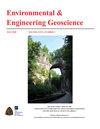Macrostructural and Microstructural Properties of Residual Soils as Engineered Landfill Liner Materials
IF 1
4区 工程技术
Q4 ENGINEERING, ENVIRONMENTAL
引用次数: 1
Abstract
This study assessed the performance of residual soils with regard to their macrostructural and microstructural properties and compatibility with leachate in pursuit of exploring alternative cost-effective and efficient landfill liner materials. A series of laboratory investigations was conducted on three residual soil samples by using tap water and leachate as permeation fluid to achieve the objectives of the study. The zeta potential measurements revealed that the presence of multivalent cations in the leachate decreased the diffuse double layer (DDL) thickness around the soil particles. The reduced DDL thickness caused a decrease in Atterberg limits of soil-leachate samples and changes in the classification of fine fractions. Additionally, the effects of pore clogging attributed to chemical precipitation and bioclogging were responsible for the reduction in measured hydraulic conductivities of soil-leachate samples. These effects can be clearly observed from the field-emission scanning electron microscopy images of soil-leachate samples with the appearance of less visible voids that led to a more compact and dense structure. The formation of new non-clay minerals and associated changes in the Al and Si ratio as reflected in the x-ray diffraction diffractograms and energy-dispersive x-ray analyses, respectively, were attributed to the effects of chemical precipitation. This study concluded that S1 and S2 residual soil samples are potential landfill liner materials because they possess adequate grading characteristics, adequate unconfined compressive strength, low hydraulic conductivity, and good compatibility with leachate. In contrast, the S3 sample requires further treatment to enhance its properties in order to comply with the requirements of landfill liner materials.工程填埋衬垫材料残土的宏观和微观结构特性
本研究评估了残留土壤的宏观结构和微观结构特性以及与渗滤液的相容性,以探索具有成本效益和效率的垃圾填埋场衬垫材料。为了达到研究目的,我们以自来水和渗滤液为渗透液,对3个残土样品进行了一系列的实验室调查。zeta电位测量结果表明,渗滤液中多价阳离子的存在降低了土壤颗粒周围扩散双层(DDL)的厚度。DDL厚度的减小导致土壤渗滤液样品的阿特伯格极限降低,细组分分类发生变化。此外,由化学沉淀和生物堵塞引起的孔隙堵塞是导致土壤渗滤液样品水力电导率降低的原因。这些影响可以从土壤渗滤液样品的场发射扫描电子显微镜图像中清楚地观察到,这些图像中出现了不太明显的空隙,导致结构更加紧凑和致密。在x射线衍射图和能量色散x射线分析中,新的非粘土矿物的形成以及Al和Si比值的变化分别归因于化学沉淀的影响。本研究认为S1和S2残土样品具有良好的级配特性、足够的无侧限抗压强度、低的水力导率以及与渗滤液的良好相容性,是潜在的填埋场衬垫材料。相比之下,S3样品需要进一步处理以增强其性能,以符合填埋场衬垫材料的要求。
本文章由计算机程序翻译,如有差异,请以英文原文为准。
求助全文
约1分钟内获得全文
求助全文
来源期刊

Environmental & Engineering Geoscience
地学-地球科学综合
CiteScore
2.10
自引率
0.00%
发文量
25
审稿时长
>12 weeks
期刊介绍:
The Environmental & Engineering Geoscience Journal publishes peer-reviewed manuscripts that address issues relating to the interaction of people with hydrologic and geologic systems. Theoretical and applied contributions are appropriate, and the primary criteria for acceptance are scientific and technical merit.
 求助内容:
求助内容: 应助结果提醒方式:
应助结果提醒方式:


